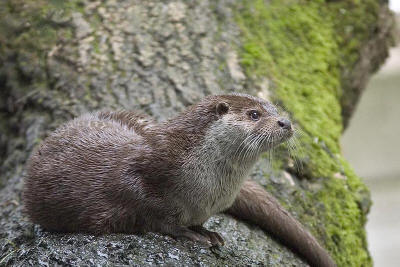An otter (an animal related to the badger)

 The
word otter derives from the Old English word otor or oter. The
word otter derives from the Old English word otor or oter.
An otter's den is called a holt or couch. A male otter is a dog, a
female a bitch, and a baby a whelp, kit, or pup. The collective nouns
for otters are bevy, family, lodge or romp, being descriptive of their
often playful nature, or when in water, raft.
The time of gestation in Eurasian otters is about 60 to 86 days. The
newborn pup is taken care of by the mother, the father, and all the
other offspring. Female otters reach sexual maturity at approximately
two years of age, while males can produce offspring at approximately
three years of age. After one month, the young otter can come out of the
cave, and after two months, it is able to swim. It lives with its family
for about one year, so it can learn and be kept safe until maturity.
Otters live up to 16 years.
Otters have long, slim bodies and relatively short limbs, with webbed
paws. Most have sharp claws on their feet, and have long, muscular
tails.
There are 13 species of otter across the world, but the only ones
native to Britain are the Eurasian otter, so they can't be confused with
any other otter species.
Normally, the Eurasian otter is 57 to 95 cm (23-37 in) long, not
counting a tail of 35-45 cm (14-18 in). The female is shorter than the
male. The otter's average body weight is 7 to 12 kg (15.4-26.4 lbs),
although occasionally a large old male may reach up to 17 kg (37 lbs).
They have very soft, insulated underfur which is protected by an
outer layer of long guard hair. This traps a layer of air, and keeps
them dry and warm under water.
Many otters live in cold waters and have very high metabolic rates to
help keep them warm. European otters must eat 15% of their body weight a
day, depending on the temperature. In water as warm as 10 °C (50 °F), an
otter needs to catch 100 grams (3.5 ounces) of fish per hour to survive.
Most species hunt for three to five hours a day, and nursing mothers up
to eight hours a day.
For most otters, fish is the staple of their diet. This is often
supplemented by frogs, crayfish and crabs. Some otters are expert at
opening shellfish, and others will feed on available small mammals or
birds. Prey-dependence leaves otters very vulnerable to prey depletion.
Otters are very active, chasing prey in the water or searching the
beds of rivers, lakes or the seas. Most species live beside water, but
river otters usually enter it only to hunt or travel, otherwise spending
much of their time on land to avoid their fur becoming waterlogged. Sea
otters are highly aquatic and live in the ocean for most of their lives.
Otters are playful animals and appear to engage in various behaviors
for sheer enjoyment. Different species vary in their social structure,
with some being largely solitary, while others live in groups – in a few
species these groups may be fairly large. |
